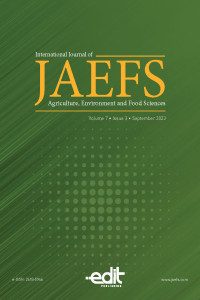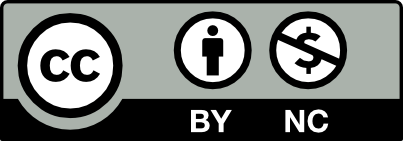Öz
Kaynakça
- Abadias, M., Usall, J., Anguera, M., Solsona, C., & Viñas, I. (2008). Microbiological quality of fresh, minimally-processed fruit and vegetables, and sprouts from retail establishments. International journal of food microbiology, 123(1-2), 121-129. https://doi.org/10.1016/j.ijfoodmicro.2007.12.013
- Aday, M. S., & Caner, C. (2014). Individual and combined effects of ultrasound, ozone and chlorine dioxide on strawberry storage life. LWT-Food Science and Technology, 57(1), 344-351. https://doi.org/10.1016/j.lwt.2014.01.006
- Bozkurt, F., Tornuk, F., Toker, O., Karasu, S., Arici, M., & Durak, M. (2016). Effect of vaporized ethyl pyruvate as a novel preservation agent for control of postharvest quality and fungal damage of strawberry and cherry fruits. LWT-Food Science and Technology, 65, 1044-1049. https://doi.org/10.1016/j.lwt.2015.09.043
- Cetin, B., Ucak Ozkaya, G., Uran, H., & Durak, M. Z. (2019). Determination of the effect of ethyl pyruvate on the surface contamination of sausage to Listeria monocytogenes by using Q‐PCR assay. Journal of Food Safety, 39(6), e12689. https://doi.org/10.1111/jfs.12689
- Çetin, B., Uran, H., & Konak, M. (2019). Effect of evaporated ethyl pyruvate on reducing Salmonella Enteritidis in raw chicken meat. Brazilian Journal of Poultry Science, 21. https://doi.org/10.1590/1806-9061-2018-0781
- Durak, M. Z., Churey, J. J., Gates, M., Sacks, G. L., & Worobo, R. W. (2012). Decontamination of Green Onions and Baby Spinach by Vaporized Ethyl Pyruvate. Journal of Food Protection, 75(6), 1012-1022. https://doi.org/10.4315/0362-028X.JFP-12-008
- Guo, M., Jin, T. Z., Gurtler, J. B., Fan, X., & Yadav, M. P. (2018). Inactivation of Escherichia coli O157: H7 and salmonella and native microbiota on fresh strawberries by antimicrobial washing and coating. Journal of food protection, 81(8), 1227-1235. https://doi.org/10.4315/0362-028X.JFP-18-007
- Guo, S., Huang, R., & Chen, H. (2019). Evaluating a combined method of UV and washing for sanitizing blueberries, tomatoes, strawberries, baby spinach, and lettuce. Journal of food protection, 82(11), 1879-1889. https://doi.org/10.4315/0362-028X.JFP-18-524
- Hoza, G., Bădulescu, L., Stan, A., Dınu, M., Becherescu, A., Zugravu, M., Frîncu, M., & Petre, A. (2020). Effect of fertilization and storage conditions on the quality of lettuce. AgroLife Scientific Journal. https://publons.com/wos-op/publon/33469251/
- Ijabadeniyi, O., Mbedla, A., & Ajayeoba, T. (2020). Microbiological quality and antimicrobial efficacy of combined oregano essential oil and acetic acid on fresh lettuce. Italian Journal of Food Science, 32(2). https://doi.org/10.14674/IJFS-1566
- Kenny, O., & O’Beirne, D. (2009). The effects of washing treatment on antioxidant retention in ready‐to‐use iceberg lettuce. International journal of food science & technology, 44(6), 1146-1156. https://doi.org/10.1111/j.1365-2621.2009.01935.x
- Kim, M. J., Moon, Y., Tou, J. C., Mou, B., & Waterland, N. L. (2016). Nutritional value, bioactive compounds and health benefits of lettuce (Lactuca sativa L.). Journal of Food Composition and Analysis, 49, 19-34. https://doi.org/10.1016/j.jfca.2016.03.004
- Koseki, S., Yoshida, K., Isobe, S., & Itoh, K. (2001). Decontamination of lettuce using acidic electrolyzed water. Journal of food protection, 64(5), 652-658. https://doi.org/10.4315/0362-028X-64.5.652
- Meireles, A., Giaouris, E., & Simões, M. (2016). Alternative disinfection methods to chlorine for use in the fresh-cut industry. Food research international, 82, 71-85. https://doi.org/10.1016/j.foodres.2016.01.021
- Millan-Sango, D., Garroni, E., Farrugia, C., Van Impe, J. F., & Valdramidis, V. (2016). Determination of the efficacy of ultrasound combined with essential oils on the decontamination of Salmonella inoculated lettuce leaves. LWT, 73, 80-87. https://doi.org/10.1016/j.lwt.2016.05.039
- Mou, B. (2008). Lettuce Vegetables I (pp. 75-116): Springer. https://doi.org/10.1007/978-0-387-30443-4_3
- Mou, B. (2009). Nutrient content of lettuce and its improvement. Current Nutrition & Food Science, 5(4), 242-248. https://doi.org/10.2174/157340109790218030
- Rossi, C., Chaves-López, C., Možina, S. S., Di Mattia, C., Scuota, S., Luzzi, I., Jenic, T., Paparella, A., & Serio, A. (2019). Salmonella enterica adhesion: Effect of Cinnamomum zeylanicum essential oil on lettuce. LWT, 111, 16-22. https://doi.org/10.1016/j.lwt.2019.05.026
- Sagdic, O. (2003). Sensitivity of four pathogenic bacteria to Turkish thyme and oregano hydrosols. Lebensmittel-Wissenschaft Und-Technologie-Food Science and Technology, 36(5), 467-473. doi: 10.1016/s0023-6438(03)00037-9. https://doi.org/10.1016/S0023-6438(03)00037-9
- Tirpanalan, O., Zunabovic, M., Domig, K., & Kneifel, W. (2011). Mini review: antimicrobial strategies in the production of fresh-cut lettuce products. Science against microbial pathogens: communicating current research and technological advances, 1, 176-188.
- Tornuk, F., & Durak, M. Z. (2015). A Novel Method For Fresh-Cut Decontamınatıon: Efficiency of Vaporized Ethyl Pyruvate in Reducing Staphylococcus Aureus And Escherichia coli O157: H7 from Fresh Parsley. Journal of Food Processing and Preservation, 39(6), 1518-1524. https://doi.org/10.1111/jfpp.12377
- Ucak Ozkaya, G., Besir, A., Metin, E., & Durak, M. (2021). Antibacterial efficacy of ethyl pyruvate treatment against Escherichia coli O157: H7 and Salmonella Typhimurium on cherry tomatoes. Acta Alimentaria. https://doi.org/10.1556/066.2020.00306
Öz
The objective of this study was to utilize vaporized ethyl pyruvate (EP) as a means to enhance the safety of lettuce for human consumption. For this purpose, the antimicrobial activity of EP was evaluated on lettuce dipping-inoculated with Escherichia coli O157:H7 ATCC 25150. Inoculated samples for antimicrobial analysis and non-inoculated samples for organoleptic analysis (color and sensorial analysis) were treated with 0, 42, 105, and 420 ppm EP and then stored at 4 °C for 7 days and 10 °C for 5 days. Following a storage period of 7 days at a temperature of 4 °C, it was observed that the EP concentrations of 42, 105, and 420 ppm resulted in reductions of 0.8, 1.5, and 3.4 log, respectively, in the population of E. coli O157:H7 on lettuce. After a period of 5 days at a temperature of 10 °C, the presence of E. coli O157:H7 was observed to decrease by 1.3, 2.1, and 2.2 log. This reduction in bacterial count was attributed to the application of 42, 105, and 420 ppm of EP, respectively. In conclusion, based on the evaluation of organoleptic and color properties, it is suggested that the treatment involving a concentration of 42 ppm EP at 10 °C for 3 days can be a viable non-thermal method for effectively inhibiting bacterial growth.
Anahtar Kelimeler
Vaporized ethyl pyruvate E. coli O157:H7 Decontamination Lettuce Food safety
Kaynakça
- Abadias, M., Usall, J., Anguera, M., Solsona, C., & Viñas, I. (2008). Microbiological quality of fresh, minimally-processed fruit and vegetables, and sprouts from retail establishments. International journal of food microbiology, 123(1-2), 121-129. https://doi.org/10.1016/j.ijfoodmicro.2007.12.013
- Aday, M. S., & Caner, C. (2014). Individual and combined effects of ultrasound, ozone and chlorine dioxide on strawberry storage life. LWT-Food Science and Technology, 57(1), 344-351. https://doi.org/10.1016/j.lwt.2014.01.006
- Bozkurt, F., Tornuk, F., Toker, O., Karasu, S., Arici, M., & Durak, M. (2016). Effect of vaporized ethyl pyruvate as a novel preservation agent for control of postharvest quality and fungal damage of strawberry and cherry fruits. LWT-Food Science and Technology, 65, 1044-1049. https://doi.org/10.1016/j.lwt.2015.09.043
- Cetin, B., Ucak Ozkaya, G., Uran, H., & Durak, M. Z. (2019). Determination of the effect of ethyl pyruvate on the surface contamination of sausage to Listeria monocytogenes by using Q‐PCR assay. Journal of Food Safety, 39(6), e12689. https://doi.org/10.1111/jfs.12689
- Çetin, B., Uran, H., & Konak, M. (2019). Effect of evaporated ethyl pyruvate on reducing Salmonella Enteritidis in raw chicken meat. Brazilian Journal of Poultry Science, 21. https://doi.org/10.1590/1806-9061-2018-0781
- Durak, M. Z., Churey, J. J., Gates, M., Sacks, G. L., & Worobo, R. W. (2012). Decontamination of Green Onions and Baby Spinach by Vaporized Ethyl Pyruvate. Journal of Food Protection, 75(6), 1012-1022. https://doi.org/10.4315/0362-028X.JFP-12-008
- Guo, M., Jin, T. Z., Gurtler, J. B., Fan, X., & Yadav, M. P. (2018). Inactivation of Escherichia coli O157: H7 and salmonella and native microbiota on fresh strawberries by antimicrobial washing and coating. Journal of food protection, 81(8), 1227-1235. https://doi.org/10.4315/0362-028X.JFP-18-007
- Guo, S., Huang, R., & Chen, H. (2019). Evaluating a combined method of UV and washing for sanitizing blueberries, tomatoes, strawberries, baby spinach, and lettuce. Journal of food protection, 82(11), 1879-1889. https://doi.org/10.4315/0362-028X.JFP-18-524
- Hoza, G., Bădulescu, L., Stan, A., Dınu, M., Becherescu, A., Zugravu, M., Frîncu, M., & Petre, A. (2020). Effect of fertilization and storage conditions on the quality of lettuce. AgroLife Scientific Journal. https://publons.com/wos-op/publon/33469251/
- Ijabadeniyi, O., Mbedla, A., & Ajayeoba, T. (2020). Microbiological quality and antimicrobial efficacy of combined oregano essential oil and acetic acid on fresh lettuce. Italian Journal of Food Science, 32(2). https://doi.org/10.14674/IJFS-1566
- Kenny, O., & O’Beirne, D. (2009). The effects of washing treatment on antioxidant retention in ready‐to‐use iceberg lettuce. International journal of food science & technology, 44(6), 1146-1156. https://doi.org/10.1111/j.1365-2621.2009.01935.x
- Kim, M. J., Moon, Y., Tou, J. C., Mou, B., & Waterland, N. L. (2016). Nutritional value, bioactive compounds and health benefits of lettuce (Lactuca sativa L.). Journal of Food Composition and Analysis, 49, 19-34. https://doi.org/10.1016/j.jfca.2016.03.004
- Koseki, S., Yoshida, K., Isobe, S., & Itoh, K. (2001). Decontamination of lettuce using acidic electrolyzed water. Journal of food protection, 64(5), 652-658. https://doi.org/10.4315/0362-028X-64.5.652
- Meireles, A., Giaouris, E., & Simões, M. (2016). Alternative disinfection methods to chlorine for use in the fresh-cut industry. Food research international, 82, 71-85. https://doi.org/10.1016/j.foodres.2016.01.021
- Millan-Sango, D., Garroni, E., Farrugia, C., Van Impe, J. F., & Valdramidis, V. (2016). Determination of the efficacy of ultrasound combined with essential oils on the decontamination of Salmonella inoculated lettuce leaves. LWT, 73, 80-87. https://doi.org/10.1016/j.lwt.2016.05.039
- Mou, B. (2008). Lettuce Vegetables I (pp. 75-116): Springer. https://doi.org/10.1007/978-0-387-30443-4_3
- Mou, B. (2009). Nutrient content of lettuce and its improvement. Current Nutrition & Food Science, 5(4), 242-248. https://doi.org/10.2174/157340109790218030
- Rossi, C., Chaves-López, C., Možina, S. S., Di Mattia, C., Scuota, S., Luzzi, I., Jenic, T., Paparella, A., & Serio, A. (2019). Salmonella enterica adhesion: Effect of Cinnamomum zeylanicum essential oil on lettuce. LWT, 111, 16-22. https://doi.org/10.1016/j.lwt.2019.05.026
- Sagdic, O. (2003). Sensitivity of four pathogenic bacteria to Turkish thyme and oregano hydrosols. Lebensmittel-Wissenschaft Und-Technologie-Food Science and Technology, 36(5), 467-473. doi: 10.1016/s0023-6438(03)00037-9. https://doi.org/10.1016/S0023-6438(03)00037-9
- Tirpanalan, O., Zunabovic, M., Domig, K., & Kneifel, W. (2011). Mini review: antimicrobial strategies in the production of fresh-cut lettuce products. Science against microbial pathogens: communicating current research and technological advances, 1, 176-188.
- Tornuk, F., & Durak, M. Z. (2015). A Novel Method For Fresh-Cut Decontamınatıon: Efficiency of Vaporized Ethyl Pyruvate in Reducing Staphylococcus Aureus And Escherichia coli O157: H7 from Fresh Parsley. Journal of Food Processing and Preservation, 39(6), 1518-1524. https://doi.org/10.1111/jfpp.12377
- Ucak Ozkaya, G., Besir, A., Metin, E., & Durak, M. (2021). Antibacterial efficacy of ethyl pyruvate treatment against Escherichia coli O157: H7 and Salmonella Typhimurium on cherry tomatoes. Acta Alimentaria. https://doi.org/10.1556/066.2020.00306
Ayrıntılar
| Birincil Dil | İngilizce |
|---|---|
| Konular | Gıda Mikrobiyolojisi |
| Bölüm | Makaleler |
| Yazarlar | |
| Yayımlanma Tarihi | 30 Eylül 2023 |
| Gönderilme Tarihi | 26 Temmuz 2023 |
| Kabul Tarihi | 24 Ağustos 2023 |
| Yayımlandığı Sayı | Yıl 2023 Cilt: 7 Sayı: 3 |
Kaynak Göster
International Journal of Agriculture, Environment and Food Sciences dergisinin içeriği, Creative Commons Alıntı-GayriTicari (CC BY-NC) 4.0 Uluslararası Lisansı ile yayınlanmaktadır. Söz konusu telif, üçüncü tarafların içeriği uygun şekilde atıf vermek koşuluyla, ticari olmayan amaçlarla paylaşımına ve uyarlamasına izin vermektedir. Yazarlar, International Journal of Agriculture, Environment and Food Sciences dergisinde yayınlanmış çalışmalarının telif hakkını elinde tutar.
Web: dergipark.org.tr/jaefs E-mail: editor@jaefs.com WhatsApp: +90 850 309 59 27



